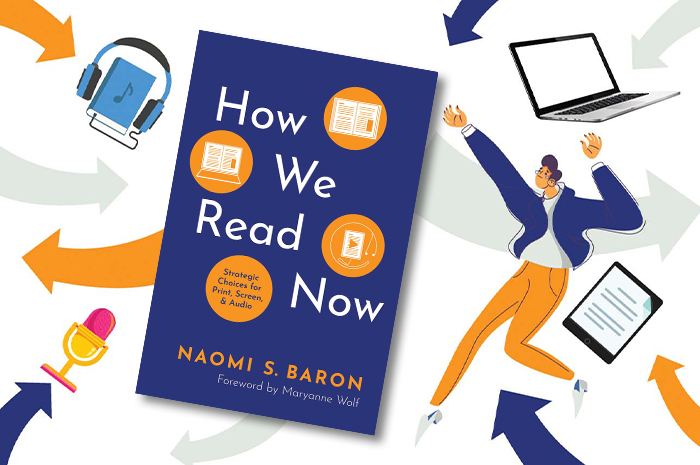
Paper or Pixels?
A noted linguist tackles the digital-age dilemma of whether print or electronic text best promotes student learning.
Review by Robin Tatu
How We Read Now: Strategic Choices for Print, Screen, and Audio
by Naomi Baron.
Oxford University Press, 2021.
305 pages.
As educators designed their fall syllabi after a year of social distancing and remote learning, many probably wondered about the merits of traditional versus online media. Not surprisingly, the answer is not a simple one, as linguist Naomi Baron explains in her nuanced, evidence-based guide to drawing maximum meaning from the written word.
How We Read Now draws on current research to offer greater understanding of the various requirements, strengths, flaws, and uses of different reading media. Studies demonstrate, for example, that print fosters better concentration than screens for longer, in-depth reading. Comprehension, recall, and integration of ideas also are heightened when reading traditionally. Audiobooks and video presentations can offer additional support for readers, particularly those with learning differences and when accompanied by written text, but invite distraction and multitasking.
Baron, an American University professor emerita of world languages and culture who specializes in studies of language and technology, also examines the commercial and societal influences that increasingly determine the choice of media. She notes, for example, that educational testing and the textbook industry are moving inexorably toward digital—the latter in part driven by cost. Students also favor multiple formats; some 44 percent now prefer to rent either e-books or traditional texts than to buy the expensive hard copy tomes. Faculty also play a role, working to lighten their students’ load by reducing and simplifying required reading assignments, though that may not help produce stronger, more analytical readers and thinkers.
Some of the cited research confirms what many educators already sense: digital reading encourages faster navigation and appeals to the Google generation of students who find print books “boring.” But Baron rejects nostalgia for the good old days of pre-digital engagement. “Print is no panacea for learning,” she writes, “And digital is no inherent villain.”
The opening section, Sizing Up Reading, addresses such overarching concepts as what we mean by “reading” and “reader,” who is reading, and what and how they are reading. Chapter 3 closes with a caution against treating print as “a gold standard” and instead urges recognition that some print strategies—such as highlighting—don’t transfer to audiobooks or other formats. Educators can ensure better student success by developing awareness of helpful learning applications for audio and video, including notetaking, rewatching/relistening, and self-quizzing. As is the practice in many engineering courses, segments of “reading” can be reinforced with hands-on labs.
Chapter 6, which explores online strategies, recommends coaching students rather than assuming internet proficiency. Undergraduates still need guidance in searching, evaluating, and synthesizing multiple online texts. They also need to understand that not all reading is done in the same manner and should be taught to recognize each format’s challenges. If we all tend to “scroll” when reading online, then we must train ourselves to slow down, take notes, and question the authority of a presentation. Instructors, who rarely evaluate the credibility of online materials, can also be more conscious about when, how, and why they assign different material.
The book’s closing section, What’s Next, raises a crucial concern about the eroding effects of digital media on reading skills. Consider how much we rely on online platforms for shopping, banking, news, communication, and other staples of daily life, writes Baron. Our increased involvement with screens large and small influences our reading habits—even when we pick up a paper book. The “digital mindset” we are all developing favors extracting information from multiple platforms simultaneously rather than careful evaluation and contemplation of ideas. How many readers pick up a traditional novel and find, as Nicholas Carr noted in his 2010 book The Shallows: What the Internet Is Doing to Our Brains, that our attention drifts after a few pages?
For Baron, solutions lie in recognition and a more methodical approach to all reading. By knowing when to slow down and focus, and by developing strategies that bolster concentration, educators can help students—and themselves—deepen engagement with, appreciation for, and learning from the written word, whatever the medium.
Robin Tatu is Prism‘s book editor.
© Amazon/Getty Images/Alexander Da Silva